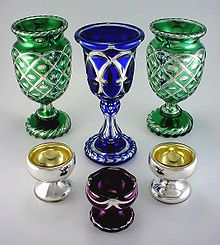- Mercury glass
-
Mercury glass is the common term for silvered glass, which describes glass that was blown double walled, then silvered between the layers with a liquid silvering solution, and sealed. Although mercury was originally used to provide the reflective coating for mirrors, elemental mercury was never used to create tableware. Silvered glass was free-blown, then silvered with a solution containing silver nitrate and grape sugar in solution, heated, then closed. Sealing methods include metal discs covered with a glass round (England) or a cork inserted into the unpolished pontil scar (American). "Mercury" silvered glass was produced originally from around 1840 until at least 1930 in Bohemia (now the Czech Republic), Germany and also manufactured in England from 1849-55. Companies in the United States, including the Boston and Sandwich Glass Co., New England Glass Co. and the Boston Silver Glass Company, made silvered glass from about 1852-80. Vases, goblets and all form of tableware were decorated with a variety of techniques including painting, enameling, etching, and engraving. Silvered "mercury" glass is considered one of the first true "art glass" types, that is, glass that was made for display and for its inherent artistic value rather than for utilitarian use.
Silvered glass is still available in a wide range of decorative items and usually marketed as mercury glass.
References
Categories:- Glass stubs
- Glass coating and surface modification
Wikimedia Foundation. 2010.

